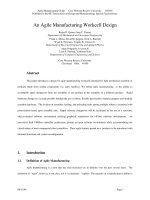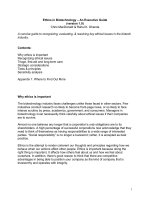individuals and interactions elektronisk ressurs an agile guide
Bạn đang xem bản rút gọn của tài liệu. Xem và tải ngay bản đầy đủ của tài liệu tại đây (6.98 MB, 218 trang )
Upper Saddle River, NJ • Boston • Indianapolis • San Francisco
New York • Toronto • Montreal • London • Munich • Paris • Madrid
Cape Town • Sydney • Tokyo • Singapore • Mexico City
Individuals and
Interactions:
An Agile Guide
Ken Howard
Barry Rogers
Many of the designations used by manufacturers and sellers to distin-
guish their products are claimed as trademarks. Where those designa-
tions appear in this book, and the publisher was aware of a trademark
claim, the designations have been printed with initial capital letters or
in all capitals.
The authors and publisher have taken care in the preparation of this
book, but make no expressed or implied warranty of any kind and as-
sume no responsibility for errors or omissions. No liability is assumed
for incidental or consequential damages in connection with or arising
out of the use of the information or programs contained herein.
The publisher offers excellent discounts on this book when ordered in
quantity for bulk purchases or special sales, which may include elec-
tronic versions and/or custom covers and content particular to your
business, training goals, marketing focus, and branding interests. For
more information, please contact:
U.S. Corporate and Government Sales
(800) 382-3419
For sales outside the United States please contact:
International Sales
Visit us on the Web: informit.com/aw
Library of Congress Cataloging-in-Publication Data
Howard, Ken, 1962-
Individuals and interactions : an agile guide / Ken Howard, Barry
Rogers.
p. cm.
Includes bibliographical references and index.
ISBN 978-0-321-71409-1 (pbk. : alk. paper) 1. Teams in the
workplace. 2. Communication. I. Rogers, Barry, 1963- II.
Title.
HD66.H695 2011
658.4’022 dc22
2011001898
Copyright © 2011 Pearson Education, Inc.
All rights reserved. Printed in the United States of America. This pub-
lication is protected by copyright, and permission must be obtained
from the publisher prior to any prohibited reproduction, storage in a
retrieval system, or transmission in any form or by any means, elec-
tronic, mechanical, photocopying, recording, or likewise. For infor-
mation regarding permissions, write to:
Pearson Education, Inc
Rights and Contracts Department
501 Boylston Street, Suite 900
Boston, MA 02116
Fax (617) 671-3447
Text printed in the United States on recycled paper at RR. Donnelley
and Sons, Crawfordsville, Indiana.
First printing April 2011
ISBN-13: 978-0-321-71409-1
ISBN-10: 0-321-71409-1
Writing a book like this cannot be done alone.
It requires a tremendous amount of knowledge, skills,
experience, and support. I dedicate this book to those
who supported me throughout this process:
My family—Mom & Dad, Kacy, Joe, Sean, TJ, Danni,
Nikki; each never doubted I would get this done.
Armand Garcia shared his extensive expertise
in psychology, which helped me understand why
we humans behave the way we do.
Finally, to my colleagues at Improving Enterprises:
Thanks for teaching me through your demonstration
of how individuals can interact productively,
and reminding me that we are a work in progress,
always improving.
—Ken Howard
I dedicate this book to my darling,
“high S” wife, Jane. Thanks for all your support
throughout my career. I also dedicate it to my two
beautiful daughters, Alicia and Nicole (“DI” and
“SC,” respectively). I love you all. I thank Dr. Abelson
for his wisdom and feedback regarding the DISC
content in the book. I also thank my good friend,
partner, and CEO, Curtis Hite for his encouragement
to everyone at Improving Enterprises to broaden our
reaches in helping the software community.
I appreciate your support as well as your friendship.
—Barry Rogers
Contents
Preface xv
Introduction 1
A Brief History of Organizational Behavior 2
Stage 1: People Are Machines
(Late 1800s–Mid 1900s) 2
Stage 2: People Are Emotional Beings
(1940s–1970s) 3
Stage 3: Organization Is a Machine
(1980s–2000s) 4
Stage 4: Empowered Teams Transform
the Organization (Current Trend) 6
Birds of a Feather 6
PART I INDIVIDUALS AND INTERACTIONS 9
Chapter 1 Autonomous Securities, LLC 11
Chapter 2 Behavior and Individuals 13
Communication Framework 14
DISC History 15
DISC Definition 15
So Why Is This Important? 17
Understanding and Accepting Others 17
Communicate in Your Own Language 19
The Language of DISC 20
Strategies for Communicating 21
How Do You Take a DISC Assessment? 22
Closing 23
ix
x
Individuals and Interactions
Chapter 3 Team Dynamics 25
An Apoplectic Dilemma 25
A Different Approach to Teams 26
Capitalizing on Strengths 28
The Anarchical Team 30
The Evolution of a Maturing Team 30
Conflict 33
Now What? 40
Closing 42
Chapter 4 Communication 43
Lingo 45
Empathy 46
Eye Contact 48
Ambiguity 49
Body Language 50
Cultural Awareness 53
Reflecting Body Language 54
Small Talk 54
Collaborative Conversations 57
The Power of Shutting Up 64
Communication Latency 65
We the People 68
Closing 69
Chapter 5 Collaboration 73
Working as a Team 73
Vox Populi 74
Group Survival 77
Problem-Solving Versus Decision Making 78
Individuals and Decisions 79
Groups and Decisions 79
Group Influence 80
Six Degrees of the Perfect Ice Cream Sundae 83
Diametrically Opposing Forces 85
Closing 88
Chapter 6 Behavior and Teams 89
Harmony/Conflict 89
Why Not Hire a Team with Members That Will
All Naturally Get Along? 92
Be Prepared for Conflict 93
Stressed Out 94
Fill the Gaps 94
Organizational or Team Culture 95
Closing 95
Chapter 7 Change 97
A True Story 97
Why Is Change Difficult? 99
Change Squirm 102
Change Apprehension 103
Fear of Changes to Self-Actualization Needs 104
Fear of Changes to Esteem Needs 105
Fear of Changes to Love/Belonging Needs 105
Fear of Changes to Safety Needs 106
Fear of Changes to Physiological Needs 106
Change Coach 107
Change Catalyst 108
Tracing to the Roots 109
Grass Roots Resistance to Change 110
Exposing the Origins 111
Exercise 113
Closing 114
Chapter 8 Motivators 115
Individual Workplace Motivators 115
Theoretical 116
Utilitarian/Economic 116
Aesthetic 117
Social 117
Individualistic/Political 117
Traditional/Regulatory 117
Why Is This Important? 118
Strategies for Motivating 119
xi
Contents
xii
Individuals and Interactions
Leveraging Strengths 122
Leadership and Environment 123
Closing 124
PART II WORKSHOP 127
Chapter 9 Team Dynamics Workshop 129
Preparation 129
Workshop Instructions 130
Pre-Workshop 130
The Workshop 132
Chapter 10 Communication Origami 139
Materials 140
Setup 140
Facilitation 141
Post-Exercise Discussion 141
Chapter 11 Bridge Building 145
Materials 146
Setup 146
Facilitation 147
Post-Exercise Discussion 148
Chapter 12 Moon Survival 151
Setup 152
Facilitation 152
Individual Exercise 152
Team Exercise 153
Scoring 153
Post-Exercise Discussion 153
Moon Survival Expert Analysis 158
Chapter 13 BalderDISC 163
Materials 164
Setup 164
Facilitation 165
Post-Exercise Discussion 166
xiii
Chapter 14 Assessing Concordance and Discordance 169
Materials 169
Setup 170
Facilitation 170
Post-Exercise Discussion 171
Chapter 15 Change Exercise 175
Overview 175
Setup 176
The Drawing Board 177
The Teams 177
Facilitation 178
Post-Exercise Discussion 179
Chapter 16 Groups and Decisions 183
Setup 183
DISC-Homogeneous Behavior 185
Appendix How to Take the DISC 187
References 195
Index 199
xv
Preface
The Agile Manifesto resulted after that legendary group of
individuals met at a Utah ski resort in February, 2001.
It’s ironic that despite buy-in and adoption of the mani-
festo, most of what has been published, spoken about,
and even practiced are things from the right half of the
manifesto. You have probably used many of the common
agile-related items such as Scrum, user stories, eXtreme
Programming, test-driven development, product backlogs,
task boards, and the list goes on and on. At a high level,
the majority of these are either processes or tools. Yet the
Agile Manifesto espouses individuals and interactions over
processes and tools.
So, why is there so much focus on process and tools?
Because they are all enablers of the values depicted in the
Agile Manifesto. For example, if you maintain a product
backlog as part of the Scrum process, you have a priori-
tized list of features, and every four weeks (or whatever
your iteration cycle is) you develop potentially shippable
code. At the end of each iteration, the product owner helps
the development team determine what they will develop
next. You can easily see that these items enable “respond-
ing to change over following a plan”; “working software
over comprehensive documentation” and “customer col-
laboration over contract negotiation.”
The one value that does not get as much attention is “in-
dividuals and interactions over processes and tools.” One
reason for this is because the majority of individuals in our
industry started out in college as computer SCIENCE or
software ENGINEERING students. Yet individuals and
Individuals and Interactions
xvi
interactions focus more on psychology and human behav-
ior. It is less black and white and less perfect. Arguably
the most common and most complex issue companies and
project teams typically face is related to human behavior
and communication.
In one of the first popular agile books, Agile Software
Development, Alistair Cockburn introduced us to agile
with an excellent discussion of the human side of develop-
ing software. He addressed culture, communication, co-
operation, and other “soft” subjects that are at the core
of agile. Since that book was published in 2002, there has
been sparse coverage.
This book is not intended to take you on a philosophical
journey. Instead, it is structured as a user’s guide. Practical
information is presented that is relevant to the issues that
project teams tend to encounter, with stories, tips, and best
practices that can be put into action. In addition, facilitator
instructions are included with valuable exercises that you
can administer with your team or that can be combined as
part of a comprehensive team dynamics workshop.
How to Use This Book
This book is written as a user’s guide to optimizing indi-
viduals and interactions on an agile project. Your use of
this book may vary based on your role.
If you are a manager, ScrumMaster, or product owner,
or play some other leadership role, you may want to make
two passes through the book: First, read the chapters to
gain a better understanding of your team and why it be-
haves the way it does. Second, choose activities described
in the book and facilitate exercises with your team to im-
prove.
If you are a consultant tasked with helping teams suc-
ceed, identify areas needing the most attention and select
content and exercises that address those areas. It can be
Introduction
There have been countless books on the subject of human
behavior and communication. Psychologists, sociologists,
organizational behavior experts, and others have conduct-
ed studies, published journal articles, taught courses, and
granted degrees in this subject area.
Sidebar
Throughout the book you’ll find complementary stories, tips,
best practices, and resources. As you read through the pri-
mary content of the book, don’t forget to take a look at these
for additional valuable information.
So why another book on this well-covered topic? This
book is the first of its kind—the first to address individuals
and interactions on an agile software project. The illustra-
tions, examples, and exercises are all specifically tailored
to address the needs of an agile team. The Agile Manifesto
begins with valuing individuals and interactions over proc-
esses and tools. Despite that, most that has been written,
taught, and implemented for the agile community focus-
es on processes and tools. This book offers a refreshing
change—the entire book is dedicated to individuals and
their interactions on an agile project.
Introduction
2
A Brief History of Organizational
Behavior
The sociology of a company is a fascinating thing to
observe. Over the past 100 years, organizational behavior
has been researched (often empirically and sometimes sci-
entifically), written about, studied, learned, transformed,
applauded, and criticized. Courses on organizational be-
havior are required in most (if not all) college business de-
gree programs, so most college educated managers have at
least a cursory understanding of the evolution of corporate
societies.
It may seem odd to attach the term sociology with an
organization, yet it’s fitting. Organizations contain soci-
etal elements such as culture, laws (policies), class (pecking
order), structure, language, and so on. Although countless
books have been written about this subject, there are just
a few key notable milestones in the evolution of organi-
zational behavior. This field of study is broad and deep,
and to better understand it, it could be sliced and diced a
variety of ways. As you begin to explore the dynamics of
a team through individuals and their interactions with one
another, look at the following four pivotal evolutionary
stages of the maturity of organizational behavior.
Stage 1: People Are Machines (Late 1800s–Mid 1900s)
In the early 1900s Frederick Taylor became one of the first
efficiency experts. He developed an approach to optimiz-
ing efficiency in organizations that was later referred to as
Scientific Management. Taylor’s principles of management
were based on the premise that workers can’t be trusted to
be productive on their own. Taylor felt that workers limit
their productivity due to the fear that if they maximize
productivity, they will run out of work and lose their jobs.
Taylor’s solution was to study their work methods care-
A Brief History of Organizational Behavior
3
fully and to develop highly prescriptive optimized proc-
esses that must be followed by all workers.
Franklin and Lillian Gilbreth were also efficiency ex-
perts whose expertise was time and motion studies of indi-
viduals. The Gilbreths would study the movements of in-
dividuals in a factory and relocate people and machines to
strike an optimal balance between energy exerted to out-
put delivered. The Gilbreths later gained some notoriety
when some of their children wrote two books about life at
home. The most popular of these books was titled Cheaper
by the Dozen. The Gilbreths had twelve children, and they
operated their household in the same efficient manner as
the factories where they worked.
Franklin Gilbreth put language records in the bathroom
so that otherwise inefficient time could be spent in a pro-
ductive activity. Probably the most outrageous story re-
ferred to the time when one of the children got a case of
tonsillitis. When consulting with the doctor and discover-
ing how much time would be required to deal with remov-
al of this one child’s tonsils, Gilbreth extrapolated how
much time would be later required if he had to repeat this
exercise eleven more times. Instead, he brought the doctor
to the house and removed the tonsils from all twelve kids
at once!
The approach used by Taylor and the Gilbreths defined
an era that overlooked the humanness of human beings.
Humans were just cogs in a machine. This may have looked
good on the balance sheet, but it was not a sustainable way
to treat people in the workplace.
Stage 2: People Are Emotional Beings (1940s–1970s)
In 1955, a factory in Illinois called Hawthorne Works be-
came the location where a pivotal change was made in how
organizational behavior was perceived. Brightness of light-
ing at the factory was adjusted upward and downward to
determine the effect on worker productivity. The study
Introduction
4
demonstrated that productivity increased not as a result
of brighter or dimmer light, but as a result of change. This
was reinforced as other superficial changes to the work-
place were made, also increasing productivity. The Haw-
thorne study showed that workers increase productivity
when interest is shown in them. The Hawthorne study led
to a new field of interest in business—addressing the emo-
tional needs of workers.
During this period, Douglas McGregor described the
contrast between Theory X and Theory Y managers. The-
ory X managers presume that employees will not work un-
less they are motivated to work. They often believe that
money is the only way to motivate an employee and that
employees must be ruled with an iron fist. Theory Y man-
agers, on the other hand, believe that employees want to
perform well at work and that in the right setting, employ-
ees will be self-motivated and productive workers.
McGregor’s work was based on another important the-
ory introduced in the same timeframe, Maslow’s hierar-
chy of needs. Maslow explains how behavior is a function
of our physiological needs and our need for safety, love,
and belonging, esteem, and self-actualization. Later in this
book, Maslow’s hierarchy of needs is offered with guid-
ance on how to address common needs conflicts that often
arise on agile project teams.
Another important contribution during this period was
the psychological inventory. A popular inventory mecha-
nism was called DISC, which analyzed and described an
individual’s behavior in a specific setting. DISC is used
throughout the book to aid in explaining why people be-
have the way they do.
Stage 3: Organization Is a Machine (1980s–2000s)
In the late 1980s, many companies were inspired to raise
their competitive edge. The expression “We must beat the
800-pound gorilla” was used liberally, referring to the
A Brief History of Organizational Behavior
5
huge companies that seemed to be successful despite them-
selves. Smaller companies saw an opportunity to operate
leaner, faster, smarter, and with more agility than the huge
companies.
MIT computer science professor Michael Hammer in-
troduced the world to Business Process Reengineering
(BPR) in 1990. BPR initiatives were rampant in many
companies in the early 1990s as they strove to drive waste
out of everything they did. Every procedure, job function,
and task was analyzed to the nth degree to assess which
added no value and could be removed. The BPR wave
lost favor with many because the original intent was lost
with the BPR process itself. BPR was properly focused on
improvement and increased efficiency, but the way BPR
initiatives were executed was highly inefficient and cost-
ly. These huge analyses efforts dragged on with reams of
published findings but little action. Many unqualified BPR
consulting firms attached themselves to the popular label
but failed to deliver the desired results. As a result, BPR be-
came a distasteful topic to executives at many companies.
Another MIT professor, Peter Senge, introduced the
concept of the learning organization during this period.
Senge presented a framework for a company to continu-
ously improve by never resting on its laurels and to learn
and adapt with every move it makes. Senge’s model was far
more abstract than Hammer’s, making it more challenging
for unqualified consulting firms to appropriately emulate.
The learning organization required a cultural shift from
the bottom up and from the top down.
The work of Hammer, Senge, and many others during
this 20–30 year period framed a significant transformation
period for businesses. The business itself was treated as an
organism that could sustain order of magnitude improve-
ment. Much like an overweight, out-of-shape person can
improve health through diet and exercise, an organization
could do the same thing. Staying with that analogy, the un-
healthy person may have gotten that way through years of
Introduction
6
ignorance and neglect. Employing a personal trainer and
dietician to coach and guide may be necessary for positive
change to occur. An unhealthy company cannot tweak a
few things here and there and expect significant improve-
ment. The works of this period caused organizations to
recognize this.
Stage 4: Empowered Teams Transform the
Organization (Current Trend)
With a foundation of understanding that people provide
the muscle and intelligence of an organization and that
an organization cannot exist without people, the current
trends in organizational behavior emphasize the power of
the people. People are not in an organization, people are
the organization. Therefore, people ought to avoid doing
silly, wasteful things. Taking away all constraints and re-
straints, people with the proper environment, knowledge,
and skills will likely approach a project pragmatically and
sensibly.
Empowering skilled people to enable their own capa-
bilities and work together productively requires an envi-
ronment of trust. This trusting environment is rare, yet it
is a mandatory prerequisite to successful employment of
agility. This book offers some motivation for moving to an
agile environment, but it places far more emphasis on the
knowledge and skills needed to employ agility with ease
and success.
Birds of a Feather
What causes a flock of birds to move in a coordinated
orchestrated fashion? How is the leader selected, and how
does the huge flock navigate changes in direction so swiftly
and smoothly that it appears to happen instantaneously?
This is one of the great mysteries of nature.
Birds of a Feather
7
Depending on the circumstances, some humans are in-
clined to lead and others to follow. Some may lead in some
situations and follow in others. Some strive to always lead,
whereas others may strive to always follow. Through the
years, scientists and scholars have tried to explain indi-
vidual and group behavior. Some of these theories have
tried to explain what is, whereas others have tried to de-
fine what could be.
Regardless of what some author chooses to write about,
humans are what they have always been. Some will lead,
some will follow, some will conform, and some will resist.
The complexities of putting more than one person together
can be the source of friction, while at the same time it can
be the spark that inspires great advancements. This book
explores the dynamics of the singular individual and the
dynamics of groups of individuals.
PART I
Individuals and
Interactions
Chapter 1 Autonomous Securities, LLC 11
Chapter 2 Behavior and Individuals 13
Chapter 3 Team Dynamics 25
Chapter 4 Communication 43
Chapter 5 Collaboration 73
Chapter 6 Behavior and Teams 89
Chapter 7 Change 97
Chapter 8 Motivators 115
11
Chapter 1
Autonomous Securities,
LLC
Nathan Patterson walked out of his annual retrospective
meeting with a great feeling. Sure, the bonus he knows he
will see in his next paycheck is nice, especially in today’s
economy. But what made him feel even better was the
amazing sense of accomplishment he felt turning around
his once underperforming organization. It was this time
last year that his job was on the line. What had happened
in the course of the past year that made things so drasti-
cally different?
At last year’s retrospective, Nathan’s group had missed
all project completion milestones at Autonomous Securi-
ties. What puzzled Nathan was that he personally hired
the entire team and, without a doubt in his mind, knew
that his employees were top-notch based on all the techni-
cal interviews and tests he administered. Nathan contem-
plated all the project artifacts and history of events and
hypothesized that the workers were simply not executing
at their full potential. So why was this amazing group of
people that Nathan assembled not performing up to his
expectations?
At the conclusion of last year’s meeting, at the end of his
rope, Nathan had decided to seek outside help and hired
Lydia Stewart, a consultant specializing in increasing team
Chapter 1 Autonomous Securities, LLC
12
efficiency. “I do not understand why we are not meeting
schedules. I assembled the perfect team, and I am using
agile processes,” Nathan explained to Lydia. Lydia imme-
diately thought to herself that it was a yellow flag when
Nathan referred to agile as a process instead of a set of
values.
After observing Nathan’s team in action, it was evident
to Lydia that the team was not behaving as a team but
as a group of individuals. She explained to Nathan that
the social factors in the workplace presented tremendous
challenges to worker productivity—more than any other
factor. Team dynamics, individual behavioral differences,
motivators, leadership styles, and numerous other factors
greatly affect productivity.
This book tells the story of how Lydia helped Nathan
transform his team into what it is today. The goal of this
book is to help you, the reader, better understand how and
why individuals behave the way they do when working on
a team. Through this transformation there is a point where
you may come to differentiate the importance of personal
success versus the success of your team. This book pro-
vides specific, detailed approaches and exercises that you
can use to help your team perform as a team.
13
Chapter 2
Behavior and Individuals
During her first week, Lydia decided to sit back and sim-
ply observe communication between members of the team.
She first attended a meeting where the team was discussing
the design of the system.
Lydia noticed that Sean was dominating most of the
conversations. As a result, most of his ideas were the ones
that defined the design. Carl and Lisa contributed to the
discussion and seemed to be having fun. David, who was
the most experienced developer in the group, was over-
powered by the conversations and could not seem to get a
word in edgewise. So he did not offer too much assistance
to the meeting. Eric seemed quite uncomfortable when
Sean put him on the spot asking his opinion on the main-
tainability of the design. Ravi wanted to get into some of
the details behind design decisions to feel comfortable that
they would work, but Sean seemed to want to drive things
fairly quickly.
By the end of the meeting, you could sense a bit of
tension among members of the team, and although they
walked away with a design, Lydia could tell not everyone
felt comfortable with the approach. The bigger issue was
not the design, however, but that the team was not acting
like a team. Some key opinions were never spoken. And
individuals were getting frustrated with one another.
15
framework for enabling better communication: the history,
definition, and importance of this framework are covered.
DISC History
The framework discussed in this chapter is called DISC.
You may have already heard of DISC because it has been
around much longer than agile and even longer than Lean
whose roots date back to the 1930s when Toyota moved
from a spinning and weaving company to a car company.
You could tie the history of DISC all the way back to 400
B.C. when Hippocrates observed humans and classified
four different behaviors.
In 1928, Dr. William Moulton Marston published a
book titled, The Emotions of Normal People, in which he
described the DISC theory. Over the years, several com-
panies have provided statistical validation and continuous
improvements to DISC.
So DISC has been around for a while. But it is only a rela-
tively recent development that it is being applied to achieve
greater communication on agile teams. Even though I had
been using DISC on my software project teams for many
years prior, I had initially heard of the association of DISC
with enabling success on agile projects during my Certified
ScrumMaster training by Craig Larman in 2006.
DISC Definition
You can think of DISC as a behavioral fingerprint. Every-
one’s behavior contains a blend of four elements, but no
two people’s blends are exactly alike. It is this blend that
drives how individuals behave. To begin to gain an un-
derstanding of DISC, it is easiest to simplify it in terms of
one’s dominant behavior. That is, if someone’s dominant
behavior is a D (with secondary I), you may simply refer
to that person’s behavior as a DI. This dominant behavior
Chapter 2 Behavior and Individuals
16
explains how people will behave and communicate. So
what do these letters mean?
The D—Dominator
D’s have a need to accomplish. They are decisive, thrive on
challenges, exercise authority, and hold themselves in high
regard. D’s have a tendency to deal straightforwardly with
people and may interrupt you in mid-sentence. They may
be perceived by others as being arrogant, opinionated, or
rude. The higher the D, the more intense these behaviors.
It should come as no surprise that many CEOs of compa-
nies are D’s.
The I—Influencer
I’s have a need to trust and talk. They trust, accept, and
like others. I’s enjoy talking and are animated (for exam-
ple, they tend to talk with their hands or full facial expres-
sions), persuasive, and optimistic. I’s may have a tendency
to become emotional or excitable and may be a poor judge
of character because they give people the benefit of the
doubt. I’s usually see the glass as half full. I’s typically
make the best communicators.
The S—Supporter
S’s have a need to support others. They are good team
players, avoid attention, have good listening skills, and are
deliberate or self-sacrificing. S’s typically build close rela-
tionships with a relatively small group of friends. High S’s
may not make the smallest decisions. You might walk all
over high S’s as long as they feel appreciated. S’s tend to
make the best team players.
The C—Critical Thinker
C’s have a need for perfection and quality. They aim for
accuracy—and have a capacity for and enjoy concentrat-
ing on details. C’s think systematically and are problem
solvers. They are typically serious, intense, thorough, and
cautious at decision making. C’s tend to set high standards







![between sea and sahara [electronic resource] an orientalist adventure](https://media.store123doc.com/images/document/14/y/ip/medium_iph1401348749.jpg)

